With the completion of the new ATSC 3.0 broadcast TV standard now imminent, technologists, business executives, and industry experts gathered last week in Washington, DC for the “NextGen TV Conference: Powered by ATSC 3.0.” Held at the Ronald Reagan Building and International Trade Center, the two-day program addressed the current testing and trials that are underway with ATSC 3.0, and the first consumer research detailing what viewers might think of the new capabilities. The discussion at various sessions regarding technologies and roadmaps should be of particular interest to our readers.
Broadcaster Describe New ATSC 3.0 Infrastructure
On a panel on Station Operations, Pete Sockett of Capitol Broadcasting envisions an environment that captures all content in 4k, and then processes this content in a 1080p workflow. At least for the time being, their thinking is that 4k is not an efficient transmission format, since displaying 4k images would require viewing at 2.5 picture-heights to match normal human visual acuity. So Capitol’s flagship station WRAL-TV will likely begin ATSC 3.0 broadcasts at 1080p, but using HDR and WCG (Wide Color Gamut) content.
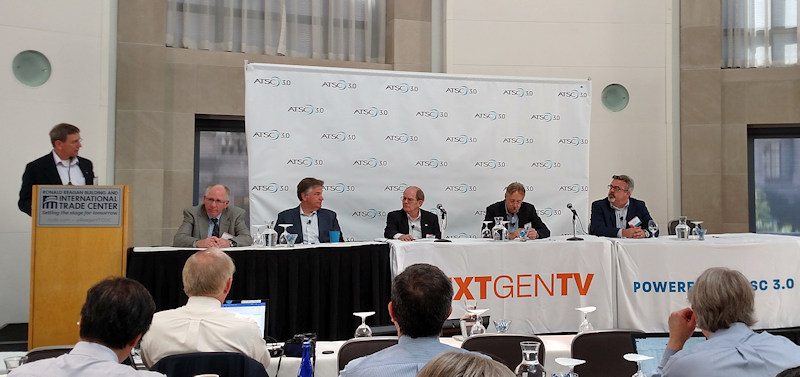 Conference panelists discuss ATSC 3.0 station operations
Conference panelists discuss ATSC 3.0 station operations
Fox Broadcasting’s Ira Goldstone echoed those sentiments, saying that their core plant operations will be based on a common “high format” that includes HDR and WCG, which will then be converted “as needed” for a particular purpose. As far as other enhancements, Steve Reynolds of Imagine Communications stressed that interactivity is likely to become essential to the ATSC 3.0 viewer experience, and that user-profiled targeting of both content and advertising would become very profitable to broadcasters.
Consumer Devices Evolve
The capabilities of consumer devices that will receive ATSC 3.0 transmissions formed the focus of a conference session entitled Display & Rendering, which was chaired by NAB’s VP of Technology Sam Matheny. There, LG’s John Taylor said they are concentrating on the new market “sweetspot” that includes both 4k UHD and 1080p HDR. Paul Hearty described Sony’s perspective that new products in the pipeline should be able to utilize core silicon used in a next generation runtime platform, a strategy that should prevent processing-component obsolescence.
As for product launches, LG is already “well on the way” to putting an ATSC 3.0 product into the South Korea market, in anticipation of the upcoming Winter Olympics. LG Electronics will include ATSC 3.0 tuners in all of its 4K TVs sold in South Korea beginning later this year, according to Taylor. (South Korean broadcasters announced last year their intention to start broadcasting in ATSC 3.0 this spring, and have since adopted it as the official over-the-air TV transmission standard.
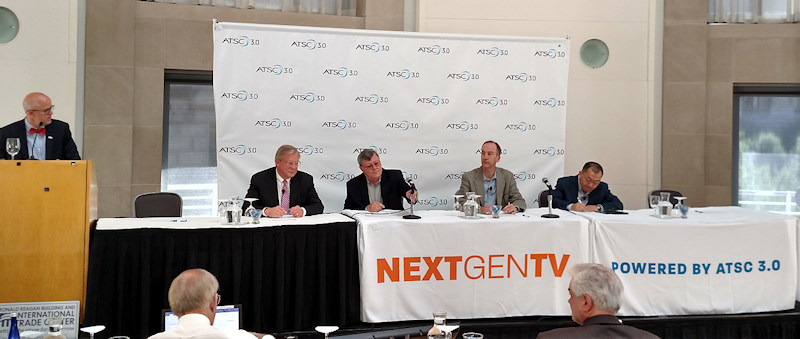 New CE devices: Display & Rendering
New CE devices: Display & Rendering
Taylor also noted that converter boxes (to display ATSC 3.0 content on existing TVs) would not be necessary – a point made in FCC filings – because simulcasting of content is expected, and the transition is currently positioned as a voluntary evolution of broadcasting. (Of course, at some date in the future, when broadcasters eventually decide to turn off ATSC 1.0 broadcasts, the issue could be revisited by the FCC. – agc)
Meanwhile, LG and others are seriously considering an integrated home gateway, with built-in electronically-steerable antenna, and Wi-fi access point, which in effect acts as a converter box that can send content over a home LAN.
Nevertheless, consumer education will be needed to ensure a market-friendly adoption of the new TVs, a point made by Brian Markwalter of the CTA (Consumer Technology Association). Paul Hearty echoed this, saying that the transition from analog to digital was “painful and tedious,” and he hopes that inter-industry cooperation can ensure consumer eagerness to replace existing TVs. To avoid confusion, however, a new “description or label” may need to be developed – a question put to Markwalter from the audience – especially with HDR and WCG entering the mix.
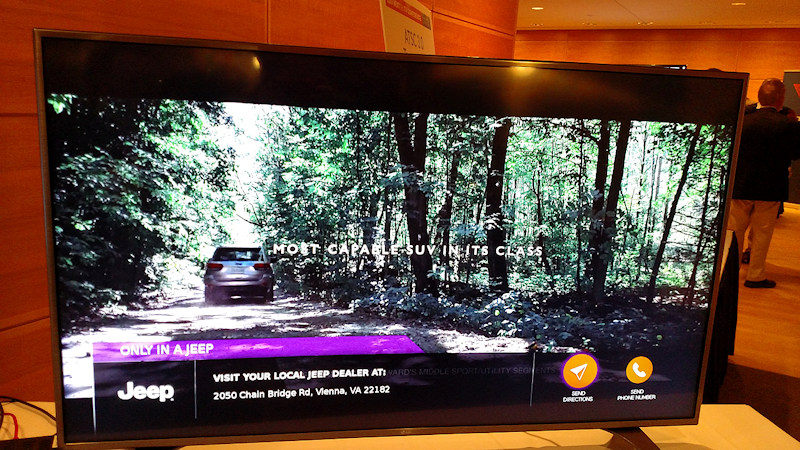 Consumer targeting is expected to be a key component of ATSC 3.0 content
Consumer targeting is expected to be a key component of ATSC 3.0 content
Hearty said that they need to “knock viewers’ socks off” with HDR and WCG, a key part of how broadcasters believe they can keep competitive with other media. And the addition of Web-based ATSC 3.0 services, says Markwalter, should make for a compelling offering, while positioning 3.0 products in a “horse race” with media players, smart TV, etc., to which Hearty adds, “this makes it a new form of the Web.” Fielding other comments on the still-cumbersome nature of user interaction with display products, Taylor offered that WebOS could be a starting point to improve the user interface.
As for product lifecycle, comments from the audience suggested that, since the display is the most expensive component in a television, an external box could be the most practical way to an upgrade path – not withstanding history – to which Hearty responded that the increasing horsepower needed to support new apps and features could make that a market necessity.
The Takeaway from the Press
A panel of media pundits gave their opinions on where the opportunities and risks will develop for ATSC 3.0, in a forum entitled, No Fake News: Editors from Industry Media Survey the Media Landscape.
Harry Jessel, of TVNewsCheck, said that mobile is the “killer app” for ATSC 3.0, perhaps impressed by the recent news and announcements by Sinclair Broadcasting to put “mobile first.” To accommodate that, he said, “we need a ‘tuner mandate’ in mobile phones,” a comment that parallels the radio industry’s pleas that the FCC require mobile carriers to put FM tuners into cell phones.
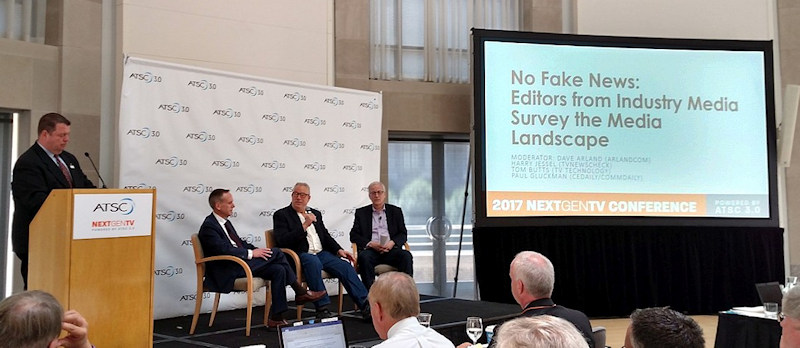 Media pundits weigh in on ATSC 3.0
Media pundits weigh in on ATSC 3.0
Moderator Dave Arland reminded the crowd, however, that a tuner mandate, while not embraced by CE manufacturers, is not universally supported by broadcasters, with at least Sinclair holding out that “it may be needed in the future.”
But one way to encourage mobile carriers would be to subsidize the hardware – notwithstanding the content competition – and Sinclair has offered to give away the chips for free, according to a quote attributed to VP Mark Aitken.
Jessel said that next on the opportunity list should be “targeted,” referring to personalized content and ad delivery, but that “no one will pay attention [to ATSC 3.0] until Les Moonves and others endorse.” In the related vein of business and consumer awareness, Paul Gluckman, CEDaily/CommDaily, lamented that “there has been no coverage of South Korea’s [ATSC 3.0] deployment in the mainstream U.S. press,” and that’s a problem. He also cautioned the industries not to repeat past mistakes, saying “don’t sell features, sell benefits.”
What’s Trending: How the market is shaping up
In a session called “What’s Trending“, Brian Markwalter presented 2017 Consumers at Retail, showing the results of recent surveys and analysis of expected trends in consumer device purchasing. He said that “consumers rate picture quality ‘high’,” and that will drive a growing market for OLED and quantum-dot displays, while at the same time offering that interactive is “a given” needed feature. Meanwhile, consumption is up on smaller screens, with tablets and phones enjoying an ever-increasing share of viewing time.
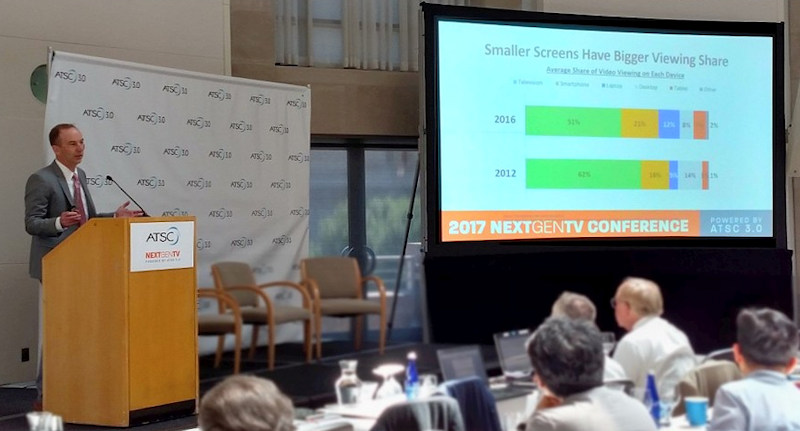 CTA’s Markwalter describes the consumer market outlook
CTA’s Markwalter describes the consumer market outlook
Benefits for Consumers
Anne Schelle of Pearl TV, Bill Hague (Magid Media Research) and Seth Geiger (SmithGeiger) discussed the benefits for Consumers on ATSC 3.0.
Hague showed results of an online survey of TV owners conducted by Magid, which included samples across consumers from ages 18 to 64. Key findings of the survey showed a solid overall interest in the ATSC 3.0 concept, with more than four out of five respondents who call it “appealing” saying that they “need” it. Of these, Millennials have the highest interest, with a “sweet spot” in the 25-34 age range. In addition, the “seamless interface of 3.0” was shown to be the top feature for Millennials and the younger Gen Z generation.
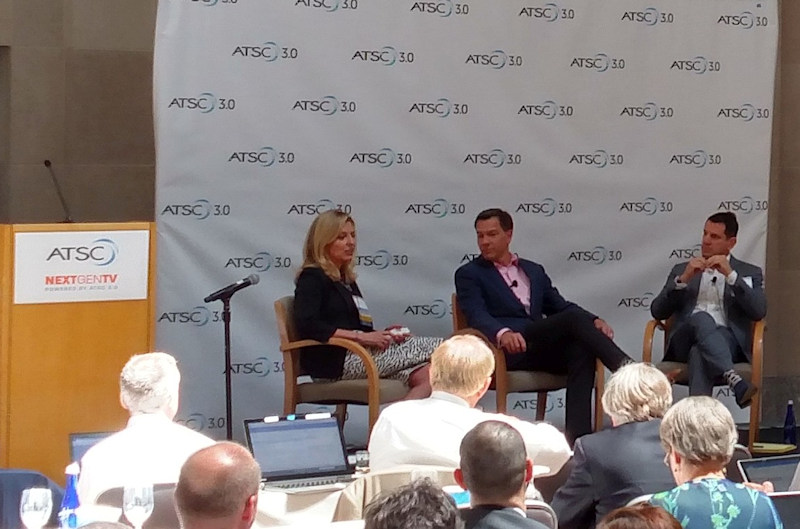 Schelle, Hague, and Geiger consider consumer appeal for ATSC 3.0 products
Schelle, Hague, and Geiger consider consumer appeal for ATSC 3.0 products
Seth Geiger said that the TV replacement cycle is starting to look like smartphone turnover, a distinct change from the days of analog displays. Disruption of the content delivery ecosystem was evident as well, said Hague, with those intending to “cord-cut” now up to 5% of all pay TV households, and 8% of Millennial pay TV households. When asked “How appealing are these potential features,” consumers said their top features were content options, and picture quality, with a clear desire for flexibility with MVPDs. Highest on this list are the following, in decreasing importance:
- Picture quality upgrade to 1080p HDR and/or 4K/Ultra HD
- Skinny bundle similar to a cable/satellite package with a smaller number of channels at a lower price than typical cable bundles
- Ability to combine streaming video services into a single interface that allows switching between streaming video services and live TV seamlessly – most valuable for Gen Z and Millennials
- Availability of newly released pay-per-view movies (available within one week of theatrical release)
- On-demand local weather updates/forecasts
- Bundle of streaming video services from the four main networks (e.g. CBS All-Access) to watch network shows on-demand
- Ability to watch live over-the-air TV programming on a smartphone or tablet connected to the home’s wireless
(Watching programming on small devices is a feature that can be made possible by the home gateway described earlier. – agc)
Marketing and education will be needed, said the panel, as is true for any new technology. While some consumers struggled to fully understand the service and its costs, every age group said they became more interested after learning more details.
— agc

